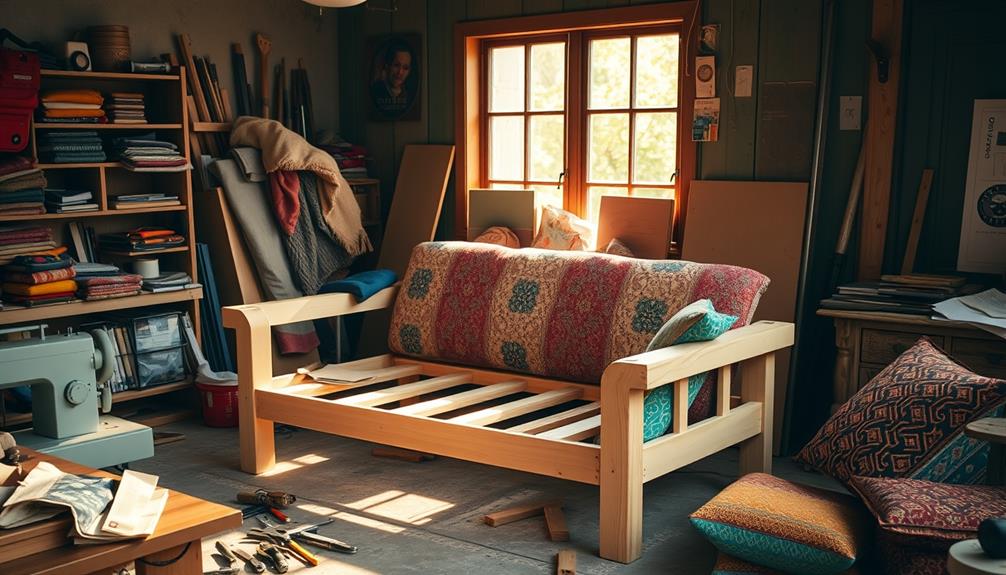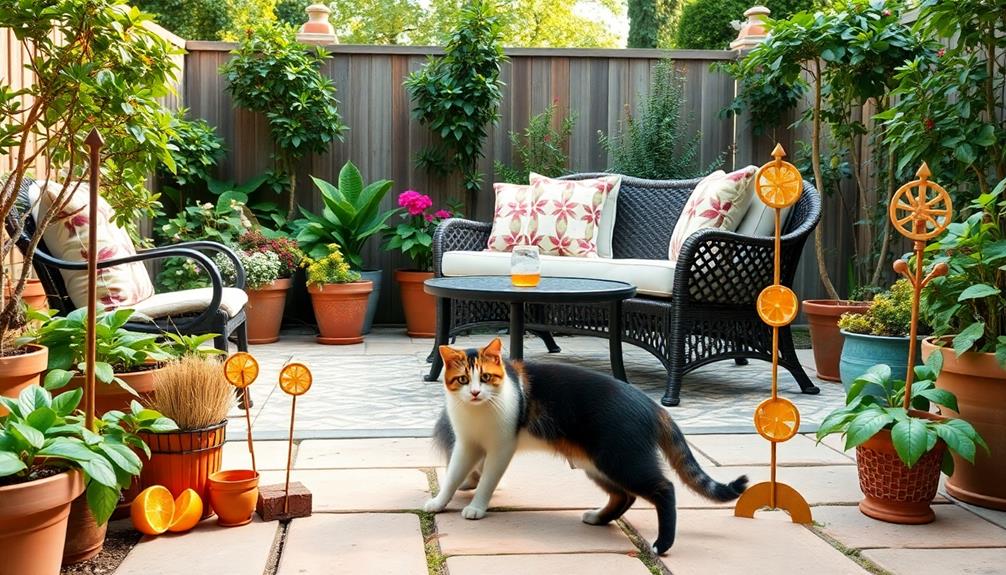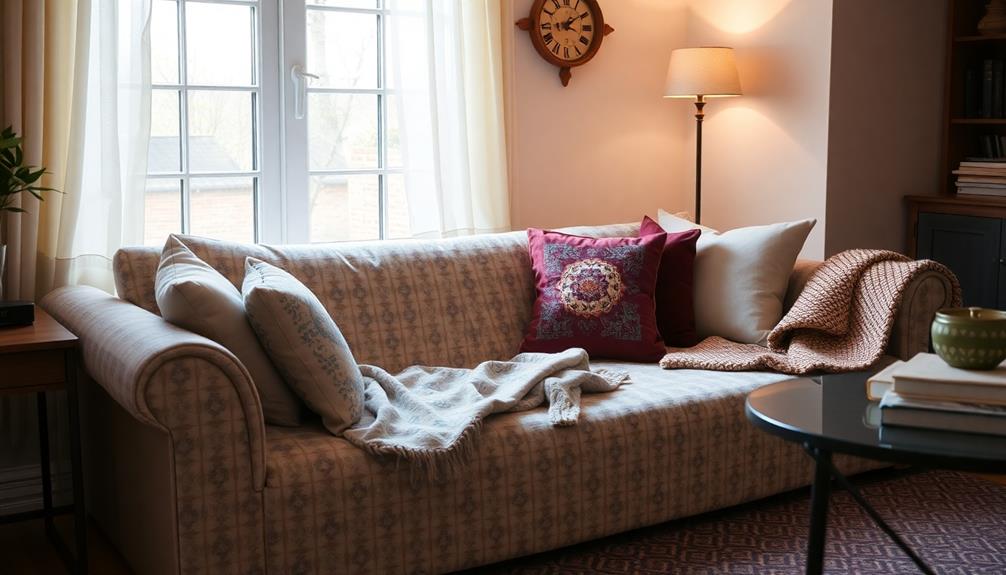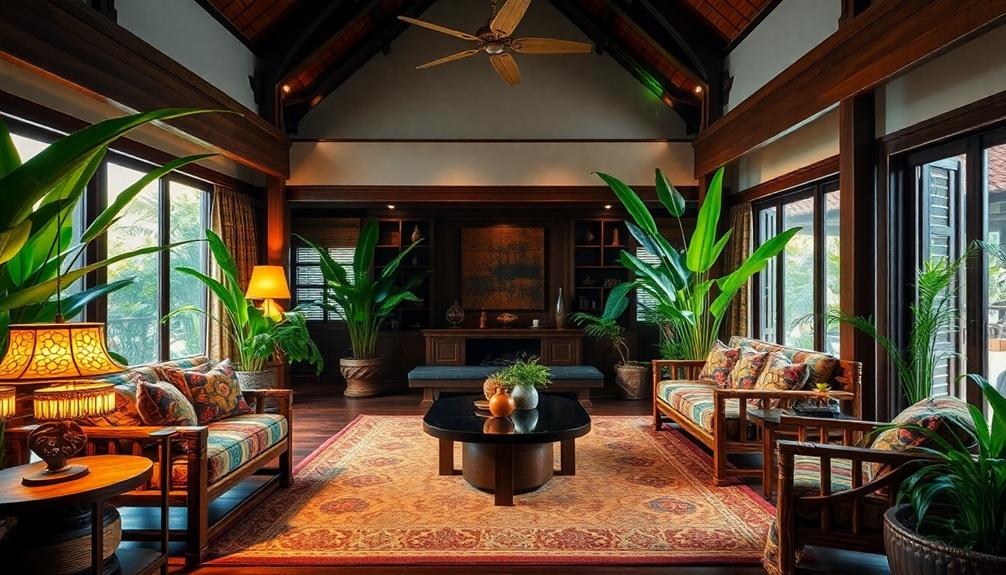You have the ability to design and make your own sofa by following these steps. Initially, sketch out your desired design and gather all the necessary materials. Start by finalizing the measurements, selecting long-lasting fabrics, and acquiring top-quality plywood. Build a robust frame using sturdy joints and incorporate support structures. Then, choose comfortable seat and back cushions ensuring they provide sufficient support. Wrap the cushions in batting, craft covers, and neatly secure the fabric for upholstery. Lastly, add final touches such as wood stain, decorative pillows, and ensure everything looks polished. There’s a lot more to discover about each stage to ensure your sofa stands out!
Key Takeaways
- Plan your sofa design by determining dimensions, style, and budget, ensuring to account for wood thickness in measurements.
- Gather essential materials including upholstery fabric, foam cushions, batting, and tools like a staple gun and sewing machine.
- Construct a sturdy sofa frame using high-quality plywood and strong joint techniques, ensuring proper support structures are in place.
- Add comfort with appropriate cushion thickness and support systems like S-Springs, maintaining recommended seat dimensions for optimal sitting.
- Upholster the sofa by tightly securing fabric over cushions and frame, finishing with decorative elements like nailheads for a polished look.
Planning Your Sofa Design
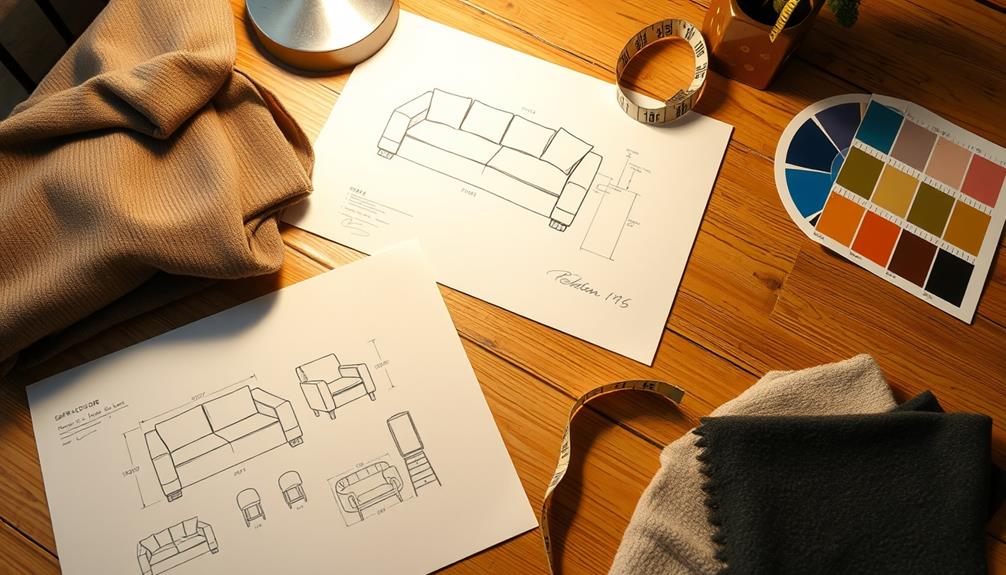
When planning your sofa design, start by determining its dimensions and style. Standard three-person sofas measure approximately 85" long, 35" deep, and 35" high, but you can customize these dimensions to fit your space.
Create initial sketches based on various designs to inspire your project, ensuring you incorporate accurate measurements that account for wood thickness. Consider also how your choice of materials can impact the ease of cleaning, especially if you have pets or allergies, similar to selecting the best vacuums for dust removal for your home.
Next, establish a budget for materials and tools. Remember that foam cushions often account for over 50% of total material costs in sofa construction, so plan accordingly.
If you're considering modular designs for easy transport, factor in how this will affect your budget as well.
Don't overlook the importance of upholstery fabrics, as your choice will greatly influence the comfort and overall appearance of your sofa. Research durable options that align with your aesthetic preferences and lifestyle needs.
Think about incorporating functional features, like USB ports, to enhance the usability of your design.
Gathering Essential Materials

To create your sofa, you'll need to gather essential upholstery supplies like fabric, foam, and batting. Aim for about 7 yards of fabric and four pieces of foam to guarantee a comfortable fit.
Consider using a high-quality fabric that can withstand wear and tear, similar to the durability found in top-rated airless paint sprayers for your projects.
Don't forget to visit local stores for durable materials that enhance your sofa's overall look.
Required Upholstery Supplies
Gathering the right upholstery supplies is vital for a successful sofa-making project. You'll need approximately 7 yards of 54-inch wide fabric to cover a standard sofa, so choose a material that suits your style and durability requirements. For a farmhouse aesthetic, consider using natural materials like cotton or linen, which beautifully complement modern farmhouse decor trends such as neutral color palettes.
For the cushions, you'll require four pieces of upholstery foam, properly measured to fit your sofa's frame dimensions. To guarantee comfort, consider using standard pillows as back cushions; typically, three pillows will provide adequate support.
Don't forget to gather additional supplies like upholstery batting, which adds softness and structure, and thread for your sewing projects. A staple gun is essential for securing the fabric tightly, while a hammer and nailheads can add decorative flair.
A sewing machine is vital for creating cushion covers; a standard machine is usually sufficient for most DIY projects. Having all these supplies on hand will streamline your process and help you create a stunning and comfortable sofa.
With everything gathered, you're ready to plunge into the fun part—bringing your vision to life!
Sourcing Quality Materials
Finding quality materials is vital for your sofa-making project. Start with sourcing foam for your cushions. You'll need four pieces of upholstery foam, so choose options that meet your desired thickness and density for ideal comfort.
For a well-crafted sofa that lasts, consider using well-draining soil for any attached planters, which can enhance the overall design. Next, focus on upholstery fabric. For a standard three-person sofa, plan on approximately 7 yards of 54-inch-wide material. This gives you a solid base for your design.
Don't overlook local fabric stores—they often have unique materials that aren't available online. This opens up more avenues for customization, allowing you to find the perfect fabric that complements your style. When selecting your upholstery fabric, prioritize durable fabrics that not only look good but also enhance the longevity of your sofa.
In addition to foam and fabric, gather essential supplies like upholstery batting, thread, spray adhesive, and a staple gun. These tools are important for achieving a polished finish, ensuring your sofa not only looks professional but also stands the test of time.
Constructing the Sofa Frame
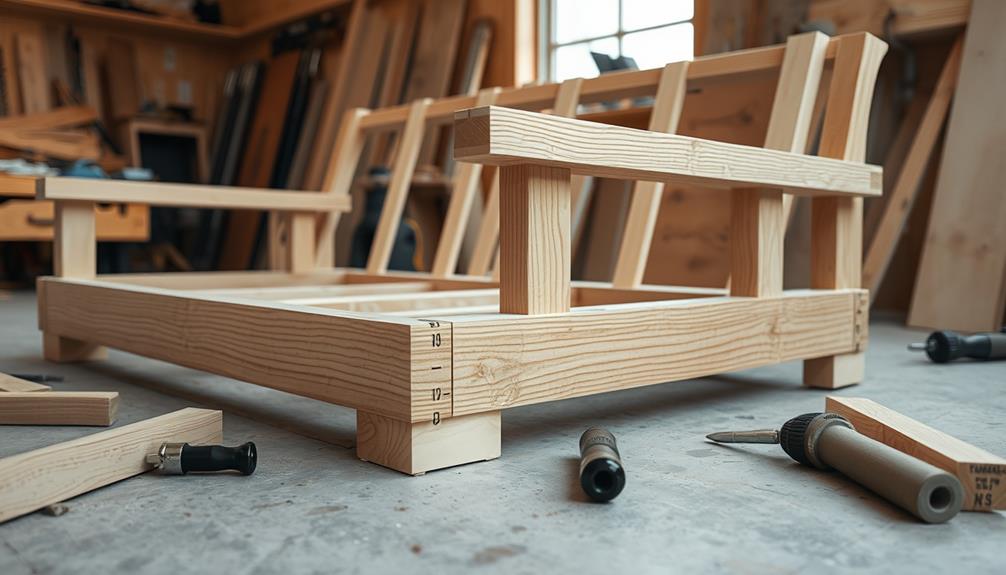
Constructing a sturdy sofa frame is vital for a comfortable and durable piece of furniture. Start by selecting high-quality plywood and make certain you account for the wood thickness in your measurements. Cutting the plywood into the specified dimensions, typically for a standard three-person sofa measuring approximately 85" long, 35" deep, and 35" high, is essential.
Additionally, consider using energy-efficient tools and methods during construction to minimize your environmental impact, as energy-efficient appliances can lower overall energy consumption.
When assembling the frame, use traditional mortise and tenon joints or pocket screws. These methods not only provide strength but also conceal fasteners for a cleaner look. As you put the pieces together, incorporate support structures like legs and cross supports. This will help distribute weight effectively and enhance durability.
Before you finalize the assembly, remember to perform a dry fit of all components. This step guarantees that measurements are accurate and that everything fits together properly.
Once you're satisfied with the fit, you can proceed to secure the frame, confident that it'll stand the test of time. By focusing on these foundational elements, you'll create a strong base for your sofa that will support the comfort and style you plan to add in later stages.
Adding Comfort and Support
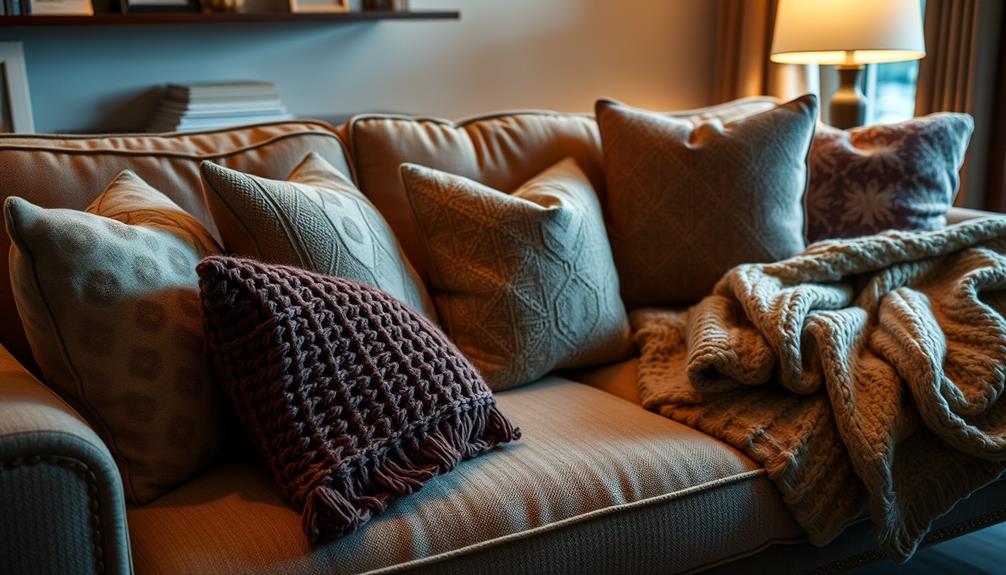
Once the frame is securely assembled, it's time to focus on adding comfort and support to your sofa. Start by selecting the right seat cushion. A good rule of thumb is to aim for a seat height between 13" and 20" for easy sitting and standing. For the best comfort, consider using S-Springs or Eight-Way Tied Springs, as they provide superior support compared to simpler webbing methods.
When it comes to foam cushions, thickness is essential. Aim for a foam cushion thickness of 4" to 6" to guarantee comfort without sacrificing support. Additionally, the seat depth should be around 20" to 21" for peak comfort, allowing you to sit back comfortably while still providing adequate leg support.
Here's a quick reference table to help you:
| Feature | Recommended Measurement | Purpose |
|---|---|---|
| Seat Height | 13" – 20" | Ease of sitting/standing |
| Foam Cushion Thickness | 4" – 6" | Comfort without compromise |
| Seat Depth | 20" – 21" | Adequate leg support |
| Support System | S-Springs/Eight-Way | Superior comfort/durability |
| Custom Cushions | Personalized | Enhanced back support |
Upholstering Your Sofa
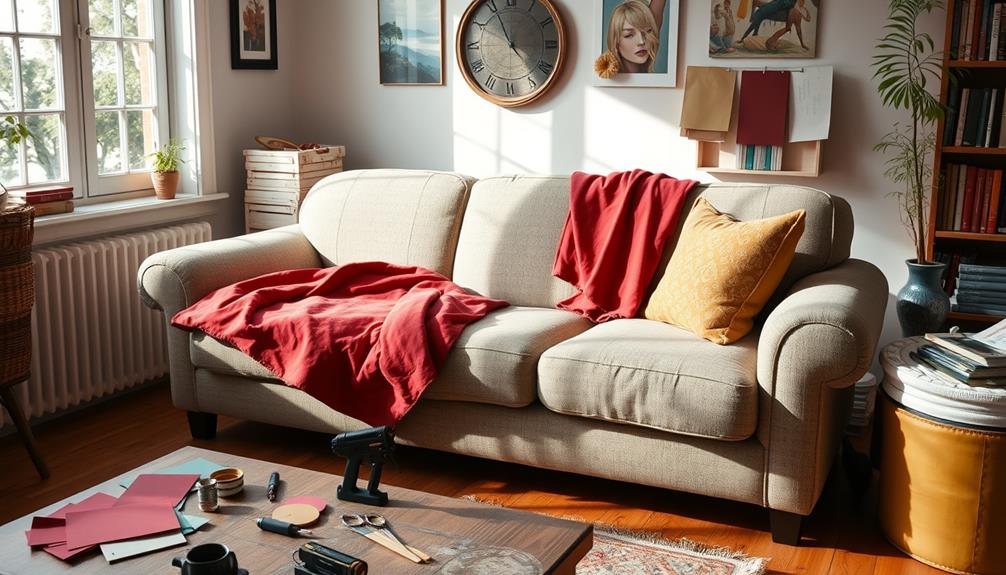
Upholstering your sofa can transform it into a stunning centerpiece for your living space. Start by gathering about 7 yards of 54-inch wide upholstery fabric to guarantee complete coverage.
Understanding your personal influences can help in selecting the perfect fabric that complements your design style, as exploration of personal tastes reveals unique design preferences.
Before you cover your foam cushions, wrap them in upholstery batting for a smooth finish. Use spray adhesive to secure the batting in place, then trim any excess.
Next, create cushion covers using an envelope-style design. This allows for easy insertion of the foam and batting without needing complex measurements.
When you're ready to attach the fabric to the sofa frame, pull it tightly over the plywood edges and secure it with staples. For an added touch of elegance, use decorative nailheads along the edges to achieve a polished look while guaranteeing the fabric distance from the frame is uniform.
Final Touches and Decor
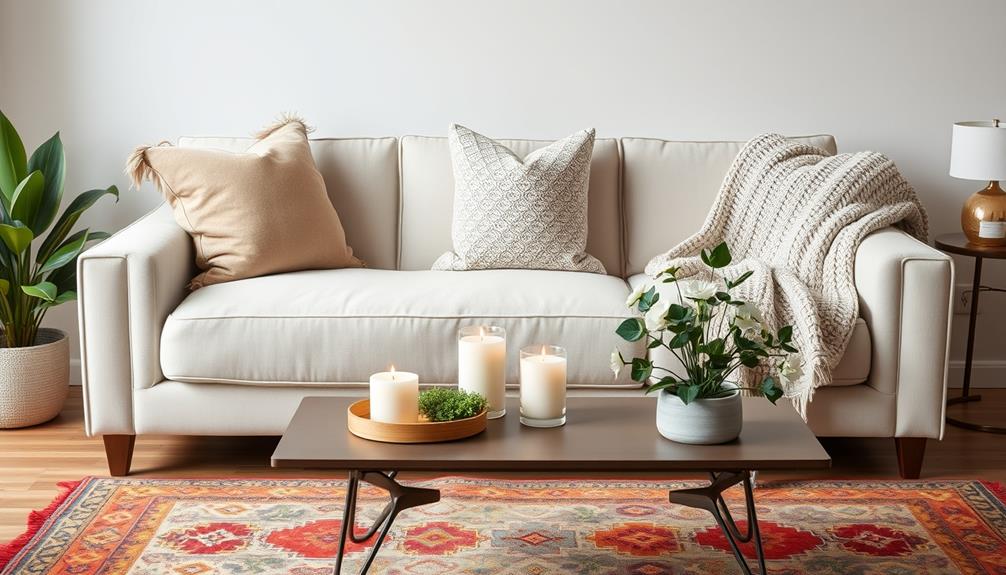
As you put the finishing touches on your sofa, consider how each detail contributes to the overall aesthetic and comfort of your living space. Start by applying wood staining and sealing to the frame, enhancing durability and visual appeal. Next, add accent pillows in varying sizes and fabrics; they not only provide comfort but allow for personalization.
Before you finalize, inspect the sofa for any rough edges or loose components. Make sure all upholstery is tight and secure, ensuring both comfort and durability.
To achieve a cohesive look, coordinate the color scheme of your sofa with surrounding decor elements. Here's a quick reference to help you visualize:
| Element | Recommendation |
|---|---|
| Accent Pillows | Mix sizes and fabrics |
| Frame Finish | Stain and seal |
| Color Coordination | Match with curtains/wall art |
Lastly, don't forget to document the finishing touches and share your completed project with the DIY community. Your insights can inspire others and showcase your design process, creating a beautiful and inviting space.
Frequently Asked Questions
How a Sofa Is Made Step by Step?
To understand how a sofa is made step by step, you start with constructing the frame, adding cushioning, sewing covers, upholstering, and finally assembling components to guarantee it's durable, comfortable, and visually appealing.
How Much Does It Cost to Build a Custom Couch?
Building a custom couch can feel like buying a small island! Typically, you're looking at around $250, but costs can soar based on materials, tools, and custom features you choose to include.
How Much Fabric Is Needed to Make a Sofa?
To determine how much fabric you need for a sofa, measure each section carefully. For a standard three-person sofa, you'll typically require about 7 yards, but always buy a little extra for mistakes.
How Do You Make a New Sofa?
Wondering how to create a new sofa? Start by sketching your design and measuring dimensions. Construct a sturdy frame, cut cushions, assemble components, and finally, cover it with fabric for a stylish finish. Once the sofa is completed, you can decorate a sofa table to complement its design. Add some decorative items such as vases, candles, or picture frames to add a personal touch to the space. Consider incorporating a table runner or a decorative tray to bring some cohesion to the overall look.
Conclusion
Now that you've crafted your sofa from scratch, you've woven together comfort and creativity into a beautiful piece of furniture. Just like a painter steps back to admire their masterpiece, take a moment to appreciate your hard work. With the right design and materials, you've created a cozy haven for relaxation and gatherings. Your new sofa isn't just a piece of furniture; it's a warm embrace in your living space, inviting friends and family to unwind.
